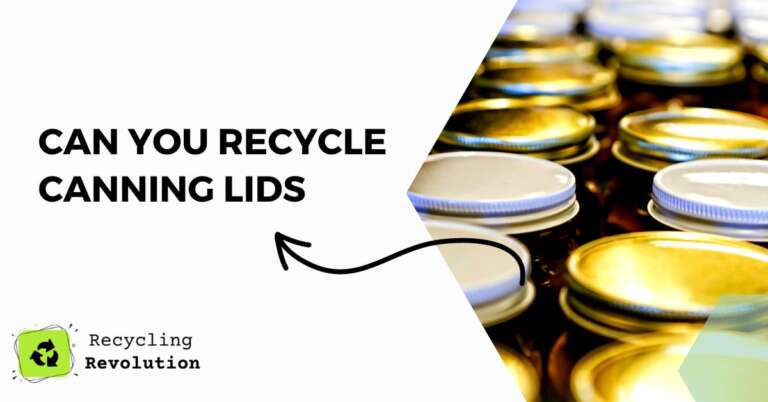Canning is a wonderful way to preserve your summer’s bounty or make delicious gifts for friends and family. But what happens when you’ve enjoyed the fruits (or vegetables) of your labor and are left with empty jars and lids?
Most of us know about recycling the glass jars, but can you recycle canning lids? The answer is more nuanced than a simple yes or no. Let’s dive in.
TL;DR: You can recycle canning lids, but not all recycling centers accept them. It’s essential to clean them thoroughly and separate the rubber seal from the metal part if possible. Recycling metal lids conserves energy and resources. When in doubt, reuse before recycling.
Deciphering The Canning Lid Composition
Before determining recyclability, it’s crucial to understand what canning lids are made of.
Metal Lids: Most canning lids are made of tin-coated steel with a thin rubber gasket for sealing. Tin and steel are recyclable materials.
Plastic Lids: Some modern canning lids are made of plastic. Plastic recycling can be trickier, as not all types are easily recyclable.
The Recycling Facility Conundrum
Remember, while a material might be recyclable in theory, it doesn’t mean your local facility will accept it.
- Size Matters: Many recycling facilities use machines to sort recyclables. Smaller items, like canning lids, might fall through the cracks. Therefore, I recommend bunching several lids together in an aluminum foil ball to prevent them from getting lost.
- Contamination Issues: Any residual food on your canning lids can contaminate the recycling process. It’s crucial to wash and dry lids thoroughly before placing them in your recycling bin.
- Material Type: For those with plastic lids, check the resin identification number (usually on the bottom of the lid). Facilities differ in the types of plastics they accept.
Environmental Impact of Recycling Metal Lids
Let’s not forget why we’re considering recycling in the first place – to reduce our environmental impact! Recycling metal uses significantly less energy than producing new metal.
In fact, recycling one ton of steel conserves 2,500 pounds of iron ore, 1,400 pounds of coal, and 120 pounds of limestone. Hence, even if it requires a tad more effort, the environmental benefits are evident.
When In Doubt, Reuse
If you’re uncertain about your recycling center’s stance on canning lids, don’t be disheartened. Reusing is often even better than recycling. Here’s why:
- Less Energy Consumption: No energy is required to transform a used item into something new when you simply reuse it.
- Versatility: Canning lids can be repurposed in a multitude of ways – as coasters, art projects, or even mini picture frames.
- Sustainability: By reusing, you’re embodying the very essence of sustainable living, maximizing the life of an item and minimizing waste.
Note: While reusing is commendable, ensure the lid’s seal is still functional for preserving food safely. Worn-out seals can compromise the quality and safety of your preserves.
The Lifecycle of Canning Lids: From Creation to Disposal
Understanding the life of canning lids from their creation to the time they’re discarded can offer perspective on why recycling or reusing them is of prime importance.
Manufacturing and Raw Materials
The production of canning lids, particularly metal ones, requires the extraction of finite raw materials from the Earth. This extraction process can be both energy-intensive and damaging to the environment.
Tin and Steel Mining: Mining activities for tin and steel can lead to deforestation, habitat destruction, and water pollution. Moreover, the refining of these ores to produce usable metal demands a significant amount of energy, often derived from fossil fuels.
Plastic Production: Plastic canning lids are typically made from petroleum-based compounds. Extracting and refining petroleum is not only energy-consuming but also contributes to greenhouse gas emissions and environmental degradation.
Why Not Just Toss Them? The Impact of Landfills
One might wonder, why not just throw away these lids if they’re so small and seemingly insignificant? The answer lies in understanding the broader impact of our waste.
Metal Lids in Landfills: While metal lids will eventually corrode and degrade in a landfill, the process can take decades. During this time, they occupy valuable space and can contribute to leachate, a toxic liquid that can contaminate groundwater.
Plastic Lids in Landfills: Plastic’s degradation is even more concerning. Instead of completely breaking down, plastic often fragments into smaller pieces called microplastics. These tiny particles can infiltrate soil and water, posing risks to wildlife and potentially entering the food chain.
Recycling Challenges & Solutions
While we’ve touched upon some basic recycling guidelines, it’s worth delving deeper into the complexities and solutions:
Variability in Recycling Programs: Recycling programs can vary wildly from one municipality to another. While one town might readily accept metal canning lids, another might not due to machinery or cost limitations. I recommend contacting your local recycling facility directly for clarity.
Upcycling: Beyond just reusing, there’s the concept of upcycling – transforming something old or discarded into a product of higher quality or value. For instance, canning lids can be upcycled into decorative magnets, candle holders, or even wall art.
The Power of Collective Action
Never underestimate the impact of collective action. If your community doesn’t accept canning lids for recycling, rallying neighbors, friends, and local businesses to request improved recycling options can be effective. Remember, recycling centers and municipal programs often operate based on community needs and demands.
Community-Based Initiatives: Some communities have set up dedicated collection points for items not traditionally accepted in recycling programs. Look for or initiate such community-driven efforts in your locality.
Beyond Recycling: Advocacy & Awareness
One step further than personal action is raising awareness about the importance of recycling and its broader implications.
Educational Programs: Consider organizing or participating in workshops or programs that educate about sustainable practices. These could be in schools, community centers, or online platforms.
Support Sustainable Brands: Many companies now produce canning lids designed with recyclability in mind or are made from post-consumer recycled materials. By supporting such brands, you send a message about the kind of products and practices you want to see in the market.
Note: It’s essential to remember that while recycling is vital, it’s just one part of the larger puzzle of sustainable living. Reducing our consumption and reusing items should always be our first line of defense against waste.
Embracing a Circular Economy
In a world striving for sustainability, the concept of a circular economy is gaining traction. This approach aims to keep resources in use for as long as possible, extract the maximum value from them, then recover and regenerate products at the end of their life. Canning lids, though small, play a role in this cycle. By ensuring they are either recycled or reused, we are making strides towards a more sustainable and circular economy.
Conclusion
So, can you recycle canning lids? Yes, but with some caveats. Make sure they’re clean, bunched together, and appropriate for your local recycling facility.
Remember that recycling is just one facet of sustainable living. If you’re ever in doubt, consider reusing your lids in innovative ways before defaulting to disposal. After all, sustainability isn’t just about recycling, it’s about thinking creatively and making the most out of what we have.
FAQs
Can I recycle plastic canning lids?
Yes, but ensure you know the type of plastic and check with your local recycling facility.
Is it safe to reuse canning lids for preserving food?
Lids can be reused if the seal is still intact and functional. Always inspect lids for any damage or signs of wear before reusing for preservation.
What are some creative ways to reuse canning lids?
Craft projects, coasters, ornaments, and mini picture frames are just a few of the endless possibilities.
How do I clean my canning lids before recycling?
Warm soapy water works best. Ensure they’re thoroughly dried before placing in the recycling bin to prevent rust.

